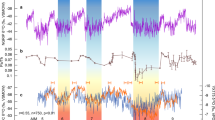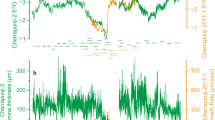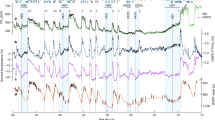Abstract
The connection between abrupt high-latitude warming during the last glacial period—Dansgaard–Oeschger (DO) events—and rapid climate changes at lower latitudes has revealed inter-hemispheric teleconnections in the ocean–atmosphere system. Links between DO events and climate variability in mid-latitude, mid-continent settings remain, however, poorly understood, especially in North America where climate archives with sufficient time resolution are scarce. Here we examine a speleothem that grew from ~70–50 thousand years ago (ka) in Wisconsin (United States) and combine fluorescent imaging of its growth banding with an annual-resolution oxygen isotope (δ18O) record. Eight large (2.0–3.0‰) negative δ18O excursions, each with an onset in <10 annual growth bands, occur between 61–55 ka, when DO events 17–14 are recorded in the ice core of the North Greenland Ice Core Project. Although the age model does not allow these δ18O excursions to be matched to specific DO events, their magnitude and rapid onset support a credible link. Isotope-enabled climate simulations suggest that abrupt DO warming would increase the δ18O of annual precipitation in the study area and corroborate that warming of >10 °C in <10 years is thus required to produce the observed negative δ18O excursions. Our findings of expansive abrupt DO warming in central North America has implications for environmental, climate and ice sheet dynamics.
This is a preview of subscription content, access via your institution
Access options
Access Nature and 54 other Nature Portfolio journals
Get Nature+, our best-value online-access subscription
$29.99 / 30 days
cancel any time
Subscribe to this journal
Receive 12 print issues and online access
$259.00 per year
only $21.58 per issue
Buy this article
- Purchase on Springer Link
- Instant access to full article PDF
Prices may be subject to local taxes which are calculated during checkout




Similar content being viewed by others
Data availability
The data that support the findings of this study are available in the National Oceanic and Atmospheric Administration palaeoclimate database: https://www.ncei.noaa.gov/products/paleoclimatology.
References
Dansgaard, W. et al. North Atlantic climatic oscillations revealed by deep Greenland ice cores. Clim. Process. Clim. Sensit. 29, 288–298 (1984).
Clement, A. C. & Peterson, L. C. Mechanisms of abrupt climate change of the last glacial period. Rev. Geophys. 46, RG4002 (2008).
Corrick, E. C. et al. Synchronous timing of abrupt climate changes during the last glacial period. Science 369, 963–969 (2020).
Wang, Y.-J. et al. A high-resolution absolute-dated late Pleistocene monsoon record from Hulu Cave, China. Science 294, 2345–2348 (2001).
Clark, J. A. The reconstruction of the Laurentide Ice Sheet of North America from sea level data: method and preliminary results. J. Geophys. Res. 85, 4307–4323 (1980).
Gregoire, L. J., Otto-Bliesner, B., Valdes, P. J. & Ivanovic, R. Abrupt Bølling warming and ice saddle collapse contributions to the meltwater pulse 1a rapid sea level rise. Geophys. Res. Lett. 43, 9130–9137 (2016).
Asmerom, Y., Polyak, V. J. & Burns, S. J. Variable winter moisture in the southwestern United States linked to rapid glacial climate shifts. Nat. Geosci. 3, 114–117 (2010).
Wagner, J. D. et al. Moisture variability in the southwestern United States linked to abrupt glacial climate change. Nat. Geosci. 3, 110–113 (2010).
Oster, J. L. et al. Millennial-scale variations in western Sierra Nevada precipitation during the last glacial cycle MIS 4/3 transition. Quat. Res. 82, 236–248 (2014).
Lachniet, M. S., Denniston, R. F., Asmerom, Y. & Polyak, V. J. Orbital control of western North America atmospheric circulation and climate over two glacial cycles. Nat. Commun. 5, 3805 (2014).
Oster, J. L., Weisman, I. E. & Sharp, W. D. Multi-proxy stalagmite records from northern California reveal dynamic patterns of regional hydroclimate over the last glacial cycle. Quat. Sci. Rev. 241, 106411 (2020).
Cheng, H. et al. The Asian monsoon over the past 640,000 years and ice age terminations. Nature 534, 640–646 (2016).
Burns, S. J., Fleitmann, D., Matter, A., Kramers, J. & Al-Subbary, A. A. Indian Ocean climate and an absolute chronology over Dansgaard/Oeschger events 9 to 13. Science 301, 1365–1367 (2003).
Cai, Y. et al. High-resolution absolute-dated Indian monsoon record between 53 and 36 ka from Xiaobailong Cave, southwestern China. Geology 34, 621–624 (2006).
Cheng, H. et al. Eastern North American climate in phase with fall insolation throughout the last three glacial–interglacial cycles. Earth Planet. Sci. Lett. 522, 125–134 (2019).
Nissen, J. High-Resolution Speleothem Record of Climate Variability During the Late Pleistocene from Spring Valley Caverns, Minnesota. M.S. Thesis, Univ. Minnesota (2018).
Dorale, J. A., Edwards, R. L., Ito, E. & González, L. A. Climate and vegetation history of the midcontinent from 75 to 25 ka: a speleothem record from Crevice Cave, Missouri, USA. Science 282, 1871–1874 (1998).
Cheng, H. et al. The climatic cyclicity in semiarid–arid central Asia over the past 500,000 years. Geophys. Res. Lett. 39, L01705 (2012).
Genty, D. et al. Precise dating of Dansgaard–Oeschger climate oscillations in western Europe from stalagmite data. Nature 421, 833–837 (2003).
Gowan, E. J. et al. A new global ice sheet reconstruction for the past 80 000 years. Nat. Commun. 12, 1199 (2021).
Batchelor, C. J. et al. Distinct permafrost conditions across the last two glacial periods in midlatitude North America. Geophys. Res. Lett. 46, 13318–13326 (2019).
Batchelor, C. J., Marcott, S. A., Orland, I. J. & Kitajima, K. Late Holocene increase of winter precipitation in mid-continental North America from a seasonally resolved speleothem record. Geology 50, 781–785 (2022).
NGRIP members. High-resolution record of Northern Hemisphere climate extending into the last interglacial period. Nature 431, 147–151 (2004).
Lachniet, M. S. Climatic and environmental controls on speleothem oxygen-isotope values. Quat. Sci. Rev. 28, 412–432 (2009).
Dansgaard, W. et al. Evidence for general instability of past climate from a 250-kyr ice-core record. Nature 364, 218–220 (1993).
Rasmussen, S. O. et al. A stratigraphic framework for abrupt climatic changes during the last glacial period based on three synchronized Greenland ice-core records: refining and extending the INTIMATE event stratigraphy. Quat. Sci. Rev. 106, 14–28 (2014).
Liu, Z. et al. Transient simulation of last deglaciation with a new mechanism for Bølling–Allerød warming. Science 325, 310–314 (2009).
He, F. Simulating Transient Climate Evolution of the Last Deglaciation with CCSM 3. PhD Thesis, Univ. Wisconsin–Madison (2011).
Blunier, T. & Brook, E. J. Timing of millennial-scale climate change in Antarctica and Greenland during the last glacial period. Science 291, 109–112 (2001).
McManus, J. F., Francois, R., Gherardi, J.-M., Keigwin, L. D. & Brown-Leger, S. Collapse and rapid resumption of Atlantic meridional circulation linked to deglacial climate changes. Nature 428, 834–837 (2004).
Ahn, J. & Brook, E. J. Atmospheric CO2 and climate on millennial time scales during the last glacial period. Science 322, 83–85 (2008).
Henry, L. G. et al. North Atlantic ocean circulation and abrupt climate change during the last glaciation. Science 353, 470–474 (2016).
Simpkins, W. W. Isotopic composition of precipitation in central Iowa. J. Hydrol. 172, 185–207 (1995).
Bryson, R. A. & Hare, F. K. Climates of North America (Elsevier, 1974).
Kim, S.-T. & O’Neil, J. R. Equilibrium and nonequilibrium oxygen isotope effects in synthetic carbonates. Geochim. Cosmochim. Acta 61, 3461–3475 (1997).
Severinghaus, J. P. & Brook, E. J. Abrupt climate change at the end of the last glacial period inferred from trapped air in polar ice. Science 286, 930–934 (1999).
Jimenez-Moreno, G. et al. Millennial-scale variability during the last glacial in vegetation records from North America. Quat. Sci. Rev. 29, 2865–2881 (2010).
Allen, J. R. et al. Rapid environmental changes in southern Europe during the last glacial period. Nature 400, 740–743 (1999).
Hughen, K. A., Overpeck, J. T., Peterson, L. C. & Trumbore, S. Rapid climate changes in the tropical Atlantic region during the last deglaciation. Nature 380, 51–54 (1996).
Deplazes, G. et al. Links between tropical rainfall and North Atlantic climate during the last glacial period. Nat. Geosci. 6, 213–217 (2013).
Steffensen, J. P. et al. High-resolution Greenland ice core data show abrupt climate change happens in few years. Science 321, 680–684 (2008).
Brownrigg, R. maps: draw geographical maps. R package version 3.4.1. https://cran.r-project.org/web/packages/maps/ (2022).
McGarry, S. F. & Baker, A. Organic acid fluorescence: applications to speleothem palaeoenvironmental reconstruction. Quat. Sci. Rev. 19, 1087–1101 (2000).
Senesi, N., Miano, T. M., Provenzano, M. R. & Brunetti, G. Characterization, differentiation, and classification of humic substances by fluorescence spectroscopy. Soil Sci. 152, 259–271 (1991).
Baker, D. G. & Keuhnast, E. L. Climate of Minnesota Part X - Precipitation Normals for Minnesota: 1941–1970 (Minnesota Agricultural Experiment Station, 1978).
Tan, M. et al. Applications of stalagmite laminae to paleoclimate reconstructions: comparison with dendrochronology/climatology. Quat. Sci. Rev. 25, 2103–2117 (2006).
Orland, I. J. et al. Climate deterioration in the eastern Mediterranean as revealed by ion microprobe analysis of a speleothem that grew from 2.2 to 0.9 ka in Soreq Cave, Israel. Quat. Res. 71, 27–35 (2009).
Orland, I. J. et al. Resolving seasonal rainfall changes in the Middle East during the last interglacial period. Proc. Natl Acad. Sci. USA 116, 24985–24990 (2019).
Kozdon, R., Ushikubo, T., Kita, N. T., Spicuzza, M. & Valley, J. W. Intratest oxygen isotope variability in the planktonic foraminifer N. pachyderma: real vs. apparent vital effects by ion microprobe. Chem. Geol. 258, 327–337 (2009).
Orland, I. J. et al. Direct measurements of deglacial monsoon strength in a Chinese stalagmite. Geology 43, 555–558 (2015).
Wycech, J. B. et al. Comparison of δ18O analyses on individual planktic foraminifer (Orbulina universa) shells by SIMS and gas-source mass spectrometry. Chem. Geol. 483, 119–130 (2018).
Tukey, J. Exploratory Data Analysis (Addison-Wesley Publishing Co, 1977).
Linzmeier, B. J., Kitajima, K., Denny, A. C. & Cammack, J. N. Making maps on a micrometer scale. Eos https://doi.org/10.1029/2018EO099269 (2018).
Ramsey, C. B. & Lee, S. Recent and planned developments of the program OxCal. Radiocarbon 55, 720–730 (2013).
Noone, D. & Sturm, C. in Isoscapes: Understanding Movement, Pattern, and Process on Earth Through Isotope Mapping (eds West, J. et al.) 195–219 (Springer, 2010).
He, F. et al. Northern Hemisphere forcing of Southern Hemisphere climate during the last deglaciation. Nature 494, 81–85 (2013).
Buizert, C. et al. Greenland temperature response to climate forcing during the last deglaciation. Science 345, 1177–1180 (2014).
He, F. & Clark, P. U. Freshwater forcing of the Atlantic meridional overturning circulation revisited. Nat. Clim. Change 12, 449–454 (2022).
Deininger, M. & Scholz, D. ISOLUTION 1.0: an isotope evolution model describing the stable oxygen (δ18O) and carbon (δ13C) isotope values of speleothems. Int. J. Speleol. 48, 21–32 (2019).
Acknowledgements
This work was supported by the US National Science Foundation (NSF) (grant P2C2-1805629 to S.A.M. and I.J.O.); the WiscSIMS Laboratory, which is supported by NSF (grants EAR-1355590, EAR-1658823); the University of Wisconsin–Madison Office of the Vice Chancellor for Research and Graduate Education with funding from the Wisconsin Alumni Research Foundation (F.H.) and the Isotope Laboratory at the University of Minnesota (R.L.E.). This research used resources of the Oak Ridge Leadership Computing Facility at the Oak Ridge National Laboratory, which is supported by the Office of Science of the US Department of Energy under contract number DE-AC05-00OR22725 (F.H.). We thank J. Klimczak and A. Wescott for their permission to collect stalagmite samples at Cave of the Mounds, R. Slaughter for sample collection help, D. Rogers for sample preparation, L. Rodenkirch for CLFM help at the University of Wisconsin–Madison Optical Imaging Core and associated colleagues for prior U–Th analyses at the University of Minnesota. Stalagmite CM-5 is curated at the University of Wisconsin–Madison Geology Museum.
Author information
Authors and Affiliations
Contributions
C.J.B. performed all sample analyses and sample processing and with S.A.M. and I.J.O conceptualized the project and acquired the funding for sample collection and oxygen isotope analysis for the project. R.L.E. provided funding and support for the geochronology of samples, while C.J.B. performed geochronological lab work on samples at University of Minnesota. F.H. performed the climate model simulation and contributed to the interpretation of oxygen isotope excursions. C.J.B., S.A.M. and I.J.O wrote the original draft, and all authors participated in the final writing and editing of the paper.
Corresponding author
Ethics declarations
Competing interests
The authors declare no competing interests.
Peer review
Peer review information
Nature Geoscience thanks Jessica Oster, Joseph Ortiz and the other, anonymous, reviewer(s) for their contribution to the peer review of this work. Primary Handling Editor: James Super in collaboration with the Nature Geoscience team.
Additional information
Publisher’s note Springer Nature remains neutral with regard to jurisdictional claims in published maps and institutional affiliations.
Extended data
Extended Data Fig. 1 Stalagmite sample CM-5 with U-Th ages and constructed age/depth model.
(Left) Cross-sectional photo of stalagmite sample CM-5, with the labelled location of U-Th pits used to identify growth periods. (Right) The constructed age-depth model using OxCal54.
Extended Data Fig. 2 Confocal laser fluorescent microscopy image of stalagmite CM-5.
A high-resolution CLFM image of the full sample transect for speleothem CM-5, with labelled locations of U-Th pits (white arrows). Note bottom to top growth direction goes from the bottom right (oldest) to the top left (youngest).
Extended Data Fig. 3 QGIS database for sample CM-5.
(a) Base reference layer of sample CM-5, which is a cross-sectional photo of sample CM-5 down the central growth axis. U-Th ages are labelled (white pits with labelled ages) and a scale down the central growth axis is shown to show how depths of each U-Th age was found. (b) CLFM image of sample CM-5 geo-referenced on top of the base layer. (c) White/reflected-light optical image of the CM-5 SIMS sample surface. (d) SIMS δ18O points measured down the central growth axis of sample CM5. (e) Zoomed-in panel showing the labelled SIMS δ18O points for a section of sample CM-5, with each individual SIMS pit being 10-μm in diameter.
Extended Data Fig. 4 Modelled summer precipitation rate (JJA, mm yr−1) in isoCAM simulations.
Plotted are modelled precipitation rate during GI (middle), GS (bottom) and the differences (GI minus GS, top). The simulated increase of the precipitation at COM originates from both Eastern Tropical Pacific and Gulf of Mexico, and therefore bring more positive δ18O from tropics to COM.
Extended Data Fig. 5 Modelled annual surface temperature (K) in isoCAM simulations.
Plotted are modelled temperature during GI (top left), GS (top right), the differences (GI minus GS, bottom left) with the significance at the 0.05 level (shading, lower right) based on 50-year simulations for GI and GS.
Supplementary information
Supplementary Information
Supplementary Discussion and References.
Supplementary Tables 1–5
This file contains Supplementary Tables S1–S5, which contains SIMS data (TS1 and TS2), modelling data (TS3 and TS5) and U–Th chronology (TS4).
Rights and permissions
Springer Nature or its licensor (e.g. a society or other partner) holds exclusive rights to this article under a publishing agreement with the author(s) or other rightsholder(s); author self-archiving of the accepted manuscript version of this article is solely governed by the terms of such publishing agreement and applicable law.
About this article
Cite this article
Batchelor, C.J., Marcott, S.A., Orland, I.J. et al. Decadal warming events extended into central North America during the last glacial period. Nat. Geosci. 16, 257–261 (2023). https://doi.org/10.1038/s41561-023-01132-3
Received:
Accepted:
Published:
Issue Date:
DOI: https://doi.org/10.1038/s41561-023-01132-3



